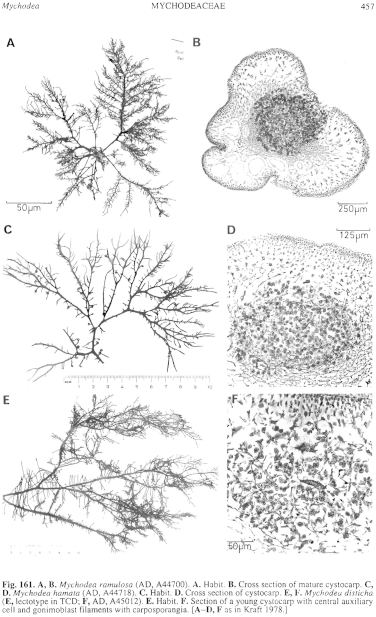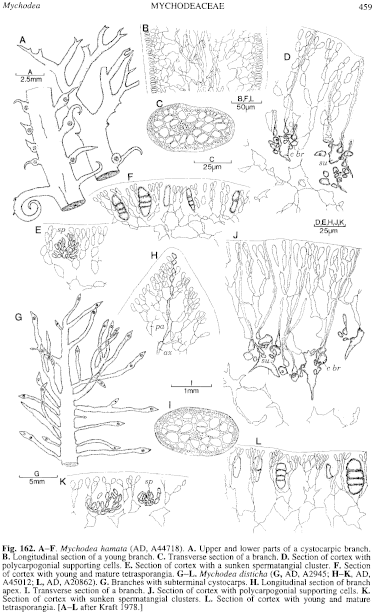|
|
|
|
|
|||||||||||
|
Electronic Flora of South Australia Species Fact Sheet
Phylum Rhodophyta – Class Florideophyceae – Order Gigartinales – Family Mychodeaceae
Selected citations: J. Agardh 1872: 35; 1876: 573. Kraft 1978: 542, figs 12, 13, 36. Kylin 1932: 65. Lucas & Perrin 1947: 156.
Synonyms
Mychodea compressa Harvey 1862: pl. 201; 1863, synop.: xlii. J. Agardh 1872: 34; 1876: 572. Kützing 1866: 26, pl. 75c, d. Kylin 1932: 65. Lucas & Perrin 1947: 156.
Mychodea nigrescens Harvey ex J. Agardh 1872: 34; 1876: 572; 1897: 52. Kylin 1932: 65, pl. 27 fig. 66. Lucas & Perrin 1947: 156.
Mychodea chondroides Kützing 1867: 24, pl. 82a.
Reproduction: Sexual thalli monoecious; procarpic; polycarpogonial. Carpogonial branches (Fig. 162J) 3-celled, 3–6 borne on enlarged inner cortical cells on both sides of ramuli, with the auxiliary cell producing gonimoblast filaments (Fig. 161F) and clusters of ovoid carposporangia 10–15 µm in diameter within a filamentous matrix. Cystocarps (1–3) in the upper part of ramuli (Fig. 162G), swelling the branchlets on both sides but not deflecting them, with slight enveloping tissue, non-ostiolate. Spermatangial clusters (Fig. 162K) scattered, sunken in the outer cortex, with initials producing 2–3 ovoid spermatangia 1.5–2 µm in diameter.
Tetrasporangia (Fig. 162L) scattered in the outer cortex, basally to laterally attached, ovoid, 40–60 µm long and 17–30 µm in diameter, zonately divided.
Type from the east coast of Tasmania (Gunn); lectotype in Herb. Harvey, TCD (Alg. Aust. Exsicc. 416 I).
Selected specimens: Port Denison, W. Aust., drift (Kraft, 14.xii.1971; AD, A44714). Eyre, W. Aust., drift (Woelkerling, 22.xi.1968; AD, A34235). 16km E of Eucla, S. Aust., drift (Womersley, 3.ii.1954; AD, A19296). Wanna, S. Aust., drift (Womersley, 19.ii.1959; AD, A22381). Tiparra Reef, S. Aust., 11 m deep on Amphibolis (Shepherd, 5.xi.1971; AD, A38312). Stenhouse Bay, S. Aust., drift (Womersley, 9.iv.1950; AD, A13184). Port Elliot, S. Aust., drift (Min-Thein, 1972; AD, A45012). Pennington Bay, Kangaroo I., S. Aust., drift (Womersley, 27.i.1946; AD, A2945). Stanley Beach, Kangaroo I., S. Aust., drift (Womersley, 27.i.1957; AD, A20862). Cape Jaffa, S. Aust., drift (Womersley, 31.viii.1949; AD, A10861). Hinders, Vic., 5–6 m deep near jetty (Kraft, Millar & Huisman, 12.i.1988; MELU, A37560). Cat Bay, Phillip I., Vic., drift (Womersley, 10.iv.1959; AD, A22720). Walkerville, Vic., drift (Sinkora A2064, 26.ii.1975; AD, A48343). Tesselated Pavement, Eaglehawk Neck, Tas., 0–1 m deep (Brown & Kenchington, 16.x.1986; AD, A57613).
Distribution: Port Denison, W. Aust., to Walkerville, Vic., and around Tasmania.
Taxonomic notes: Thallus (Fig. 161E) medium to dark red-brown, fading to grey-brown, drying cartilaginous, 20–45 cm high, erect, with moderately compressed axes 1–4 mm broad bearing distichous, usually crowded, compressed laterals from the margins (Fig. 162G), more or less at right angles, usually 1–4 cm long and 2–5 mm broad; older ones sometimes with short surface ramuli; laterals and ramuli with acute apices and bases usually slightly constricted. Holdfast discoid, 2–4 mm across, with one to a few axes; epiphytic on Amphibolis or larger algae, or epilithic. Structure uniaxial, usually with a distinct apical cell and a central axial filament (Fig. 162H) in young branches but becoming indistinguishable below in the filamentous central medulla (Fig. 162I), an outer medulla of large cells and slender filaments, and a cortex of anticlinal filaments, outer cells elongate-ovoid to clavate, 2–4 µm in diameter. Rhodoplasts discoid to elongate, ribbon like in inner cells.
M. disticha is one of the largest species of Mychodea, distinguished by the distichous branching, cystocarps in the upper part of straight ramuli, discoid holdfast (c.f. M. ramulosa) and lack of tendrils (c.f. M. hamata). It is usually a deeper-water species on rough-water coasts.
References:
AGARDH, J.G. (1872). Bidrag till Florideernes Systematik. Acta Univ. hind. 8, 1–60.
AGARDH, J.G. (1876). Species Genera et Ordines Algarum. Vol. 3, Part 1 - Epicrisis systematis Floridearum, pp. i-vii, 1–724. (Weigel: Leipzig.)
AGARDH, J.G. (1897). Analecta Algologica. Cont. IV. Acta Univ. lund. 33, 1–106, Plates 1, 2.
HARVEY, W.H. (1860a). Algae. In Hooker, J.D., The Botany of the Antarctic Voyage. 111. Flora Tasmaniae. Vol. II, pp. 321–343, Plates 185–196.
HARVEY, W.H. (1862). Phycologia Australica. Vol. 4, Plates 181–240. (Reeve: London.)
HARVEY, W.H. (1863). Phycologia Australica. Vol. 5, Plates 241–300, synop., pp. i-lxxiii. (Reeve: London.)
KÜTZING, F.T. (1866). Tabulae Phycologicae. Vol. 16. (Nordhausen.)
KÜTZING, F.T. (1867). Tabulae Phycologicae. Vol. 17. (Nordhausen.)
KRAFT, G.T. (1978). Studies of marine algae in the lesser-known families of the Gigartinales (Rhodophyta). III. The Mychodeaceae and Mychodeophyllaceae. Aust. J. Bot. 26, 515–610.
KYLIN, H. (1932). Die Florideenordnung Gigartinales. Lunds Univ. Årsskr. N.F. Avd. 2, 28 (8), 1–88, Plates 1–28.
LUCAS, A.H.S. & PERRIN, F. (1947). The Seaweeds of South Australia. Part 2. The Red Seaweeds. (Govt Printer: Adelaide.)
The Marine Benthic Flora of Southern Australia Part IIIA complete list of references.
Publication:
Womersley, H.B.S. (14 January, 1994)
The Marine Benthic Flora of Southern Australia
Rhodophyta. Part IIIA, Bangiophyceae and Florideophyceae (to Gigartinales)
Reproduced with permission from The Marine Benthic Flora of Southern Australia Part IIIA 1994, by H.B.S. Womersley. Australian Biological Resources Study, Canberra. Copyright Commonwealth of Australia.
Illustrations in Womersley Part IIIA, 1994: FIGS 161E, F, 162 G–L.

Figure 161 enlarge
Fig. 161. A, B. Mychodea ramulosa (AD, A44700). A. Habit. B. Cross section of mature cystocarp. C, D. Mychodea hamata (AD, A44718). C. Habit. D. Cross section of cystocarp. E, F. Mychodea disticha (E, lectotype in TCD; F, AD, A45012). E. Habit. F. Section of a young cystocarp with central auxiliary cell and gonimoblast filaments with carposporangia. [A–D, F as in Kraft 1978.]

Figure 162 enlarge
Fig. 162. A–F. Mychodea hamata (AD, A44718). A. Upper and lower parts of a cystocarpic branch. B. Longitudinal section of a young branch. C. Transverse section of a branch. D. Section of cortex with polycarpogonial supporting cells. E. Section of cortex with a sunken spermatangial cluster. F. Section of cortex with young and mature tetrasporangia. G–L. Mychodea disticha (G, AD, A2945; H–K, AD, A45012; L, AD, A20862). G. Branches with subterminal cystocarps. H. Longitudinal section of branch apex. I. Transverse section of a branch. J. Section of cortex with polycarpogonial supporting cells. K. Section of cortex with sunken spermatangial clusters. L. Section of cortex with young and mature tetrasporangia. [A–L after Kraft 1978.]

|
Email Contact: State Herbarium of South Australia |

|